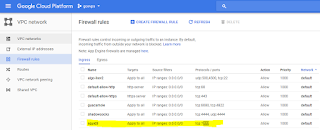Set up proxy server on your google compute engine via squid
Install squid
sudo apt install squid3
Install apache utils
sudo apt-get install apache2-utils
This Installs the htpasswd utility that allows for creating password files.
Copy the default configuration file to back it up.
This configuration file is ridiculously huge and has way more than any simple case would need. We will just back it up and make a new one with only the information that we need.
sudo cp /etc/squid/squid.conf /etc/squid/squid.conf.original
Delete the old configuration file
sudo rm /etc/squid/squid.conf
Make a new configuration files
sudo vi /etc/squid/squid.conf
Enter this in the config file
auth_param basic program /usr/lib/squid/basic_ncsa_auth /etc/squid/passwords
auth_param basic realm proxy
acl authenticated proxy_auth REQUIRED
http_access allow authenticated
# Choose the port you want. Default is 3128, but we set it to 7777
http_port 7777
The first bit (4 lines) sets squid to require passwords
The last bit configures squid to use port 7777. You can change this to anything you want.
Save the file in vi with [esc]:wq
Set up the username and password
sudo htpasswd -c /etc/squid/passwords [username]
Replace [username] with any username you want to use
You will be asked to enter and reenter a password for the username that you entered. make sure they match.
Restart the squid service
sudo systemctl restart squid.service
The last step, please not forget to set up a new firewall rule for http_port
sudo apt install squid3
Install apache utils
sudo apt-get install apache2-utils
This Installs the htpasswd utility that allows for creating password files.
Copy the default configuration file to back it up.
This configuration file is ridiculously huge and has way more than any simple case would need. We will just back it up and make a new one with only the information that we need.
sudo cp /etc/squid/squid.conf /etc/squid/squid.conf.original
Delete the old configuration file
sudo rm /etc/squid/squid.conf
Make a new configuration files
sudo vi /etc/squid/squid.conf
Enter this in the config file
auth_param basic program /usr/lib/squid/basic_ncsa_auth /etc/squid/passwords
auth_param basic realm proxy
acl authenticated proxy_auth REQUIRED
http_access allow authenticated
# Choose the port you want. Default is 3128, but we set it to 7777
http_port 7777
The first bit (4 lines) sets squid to require passwords
The last bit configures squid to use port 7777. You can change this to anything you want.
Save the file in vi with [esc]:wq
Set up the username and password
sudo htpasswd -c /etc/squid/passwords [username]
Replace [username] with any username you want to use
You will be asked to enter and reenter a password for the username that you entered. make sure they match.
Restart the squid service
sudo systemctl restart squid.service
The last step, please not forget to set up a new firewall rule for http_port
❤️ Support This Blog
If this post helped you, you can support my writing with a small donation. Thank you for reading.


Comments
Post a Comment